Valdez
Above 4,000ftConsiderable
2,000 to 4,000ftConsiderable
Below 2,000ftConsiderable
Degrees of Avalanche Danger
Avalanche Problems
Problem 1
We have just received our most significant snowfall for our area in a month. Temperatures warmed throughout the storm creating an upside down snowpack at the surface. There is a shallow/weak snowpack in place that will need time to adjust to this new load. In the meantime, human triggered avalanches will be likely in terrain steeper than 30°. Convex terrain, and areas loaded by southeast wind will be the most susceptible. Watch for signs of instability such as shooting cracks and collapsing that indicate areas of unstable snow.
Rain on snow and above freezing temperatures below 2000′ will create the potential for wet loose avalanches at low elevations.
Likelihood:
- Almost Certain
- Very Likely
- Likely
- Possible
- Unlikely
Size:
- Historic
- Very Large
- Large
- Small
Trend
- Increasing
- Steady
- Decreasing
Problem 2
New snow, strong winds and increasing temperatures have combined to stress weak/ faceted snow within our snowpack. At this point we do not have a typical coastal Alaskan snowpack. Instability and natural avalanche cycles are likely with smaller changes in weather than what is typical. It is always important to use caution while a snowpack is undergoing changes. It is especially important with our current setup.
The most likely places to trigger a persistent slab avalanche will be in thin rocky areas or anywhere the snowpack is thinner and the weak layer is closer to the surface. Other areas include places that have not been affected by recent wind events, and locations north of Thompson pass where colder temperatures has created an even weaker snowpack.
Photo of developed facets found on Catchers Mitt on 1/6, 2mm grid. The depth of these facets varies greatly depending upon wind redistribution. These were found just below the surface in a wind scoured area. On lee sides of terrain features facets may be found beneath 2-3+ feet of knife hard wind slabs.
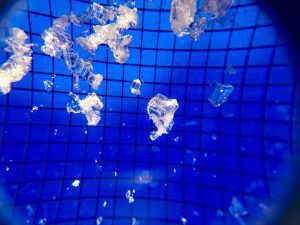
Likelihood:
- Almost Certain
- Very Likely
- Likely
- Possible
- Unlikely
Size:
- Historic
- Very Large
- Large
- Small
Trend
- Increasing
- Steady
- Decreasing
Avalanche Activity
1/1-1/4- The new years day wind event created an avalanche cycle that was difficult to document due to crowns being rapidly reloaded by 80 mph winds. Below are photos of a couple very large slides that were still visible in the Hippie ridge area. Naturals were also noted on Three Pigs, 40.5 Mile, Crudbusters, Python Buttress.

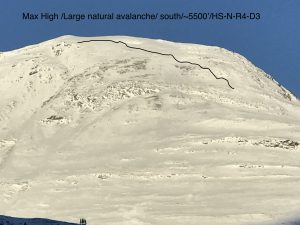
12/29- Multiple natural wet loose D1-D2’s were observed in the Port of Valdez with no step downs noted.
12/23- Berlin Wall north face ~5000′ HS-N-R3-D2-O. It is possible this occurred on 12/21, although it was not observed until 12/24.
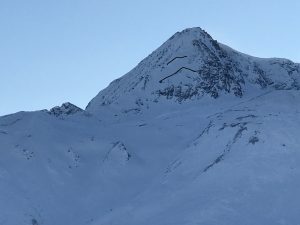
12/21- Numerous natural avalanches observed all along the north side of Thompson Pass, as a result of strong NE wind event along with a couple inches of new snow and rising temperatures. Observed naturals on all aspects except windward slopes with crowns originating from 1000 feet to 5500 feet in elevation. Most of these were hard slab avalanches. Crown depths were difficult to discern due to reloading, although some crowns looked to be up to 2 meters in depth.
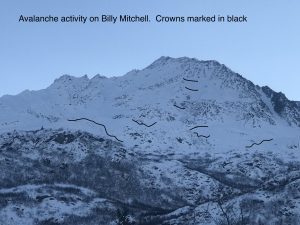
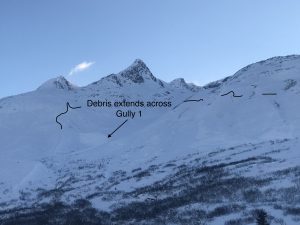
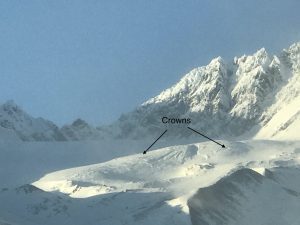
12/19- D 2.5 natural avalanches were observed on the north facing buttress west of Gully 1 and Schoolbus.
12/14- Several natural avalanches were observed although poor visibility prevented a full view of the action. The most notable natural was observed in Nicks Happy Valley on a NW aspect ~4000′. Crown depth was not visible. Debris ran down the valley and piled up at the typical snowmachine pickup.
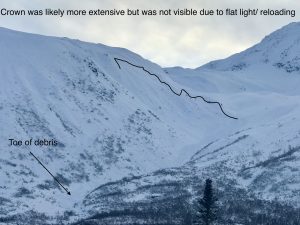
12/8- Large remote trigger/ sympathetic avalanche event occurred 12/8 with avalanches extending from Gully 1 to Nicks. Avalanches were soft slabs that ranged in size from D1-D3. Over 10 separate avalanches were counted with crown depths averaging 2-3′. One avalanche had a crown length of half a mile while another was triggered over a mile away from the point of collapse. See observation section for full report and more photos.
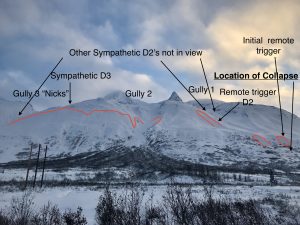
12/7- Only a few natural avalanches were noted during the last storm. It is likely there were more during the storm, but crowns may have been filled in by subsequent wind and snow.
D2’s on Town mountain was observed ~3000′
A couple of D2’s were noted in N. Oddessey gully and Big Oddessey.
D2 on 40.5 mile peak ~5500′.
12/2-12/3- Several natural D2 avalanches were noted on south aspects of Three pigs, Hippie Ridge and Averys. These windslab avalanches originated between 4000-5500 feet elevation.
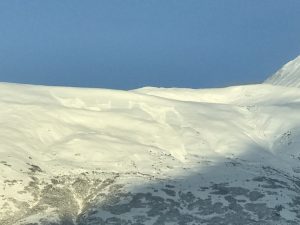
Weather
NWS Watches and Warnings
None
Point forecast for Thompson Pass
Detailed forecast for Thompson Pass (mid elevation 2000-4000′)
DATE FRIDAY 01/14 SATURDAY 01/15
TIME (LT) 06 12 18 00 06 12 18 00 06
CLOUD COVER OV SC BK OV OV OV OV OV OV
CLOUD COVER (%) 75 35 65 85 95 100 95 70 80
TEMPERATURE 29 22 20 20 22 26 24 20 17
MAX/MIN TEMP 29 19 26 15
WIND DIR SE NW NW E SE E S S E
WIND (MPH) 23 5 3 4 3 8 11 9 5
WIND GUST (MPH) 57
PRECIP PROB (%) 70 10 20 20 60 80 80 60 50
PRECIP TYPE S S S S S S S S
12 HOUR QPF 0.05 0.02 0.15 0.17
12 HOUR SNOW 0.4 0.0 1.7 2.1
SNOW LEVEL (KFT)0.9 0.6 0.8 0.8 0.9 0.7 0.4 0.1 0.0
Snow and Temperature Measurements
| Date: 01/14 | 24 hr snow | HN24W* | High Temp | Low Temp | Weekly SWE (Monday- Sunday) | January Snowfall | Season Snowfall | HS (Snowpack depth) |
| Valdez | 5.5 | 1 | 32 | 28 | 1.69 | 19 | 103 | 31 |
| Thompson Pass | ~14 | N/O | 28 | 24 | N/O | 33 | 198 | N/O |
| 46 Mile | 10 | 1 | 39 | 16 | 1.2 | 16 | 47** | 32
|
All snowfall measurements are expressed in inches and temperature in Fahrenheit. 24 hour sample period is from 6am-6am.
* 24 hour snow water equivalent/ SWE.
** Season total snowfall measurements for 46 mile began December 1st.
Season history graphs for Thompson Pass
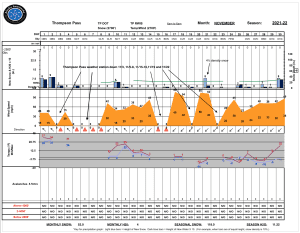
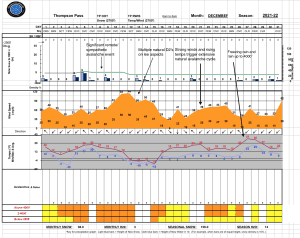
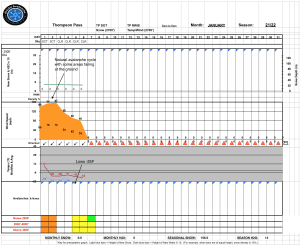
Click on links below to see a clear and expanded view of above Season history graphs
Additional Information
Winter weather began early this season, with valley locations receiving their first snowfall on the last day of Summer (September 21st). Following this storm, above average temperatures and wet weather occurred from late September through early November. During this time period Thompson Pass received 96 inches of snowfall by November 7th and Valdez recorded 7.73″ of rain.
After the 7th of November our region experienced a sharp weather pattern change. Temperatures dropped below seasonal norms and snowfall became infrequent. Between the time frame of November 7th- November 28th Thompson Pass only reported 19″ of snow with 1.1″ of Snow water equivalent (SWE). Temperatures remained below 0° F for most of the period. This cold/dry weather caused significant faceting of the snowpack, with poor structure the result.
Moderate snowfall returned to our area the last day of November and deposited 6-12 inches of new snow. The amount varied depending upon the locations’ proximity to the coast. As the storm exited on the 2nd of December it was quickly replaced by moderate to strong northeast winds.
On 12/5-12/6 Valdez received 2 feet of new snow with Thompson Pass reporting 16″. Blaring red flags like collapsing, shooting cracks and propagation in stability tests were immediately present. On 12/8 a significant remote/ sympathetic avalanche event occurred from Gully 1 through Nick’s Happy Valley.
Strong outflow winds began on 12/11 with periods of light snowfall. This has caused slab thicknesses to become variable in areas exposed to NE winds.
A fair amount of natural avalanche activity occurred during the 12/11 wind event mostly on southerly aspects. The week following this wind event fairly benign weather occurred which allowed the snowpack to adjust and for stability to improve although snowpack structure has remained poor.
On 12/21 our area received a couple inches of snow along with temperatures rising and strong outflow winds. This combination of weather kicked off a fairly significant natural avalanche cycle. Many of the slabs appeared to be deeper wind slabs that were created from the 12/11 wind event. These failed on faceted snow created in November. The event is yet another indicator of our poor snowpack structure and its inability to receive any major change in weather without the avalanche hazard rising in conjunction.
On 12/26-28 warm air moved in at elevation and caused light rain to fall up to ~4000′. A very thin rain crust was formed in many locations that was unable to support a persons weight.
A prolonged period of strong north winds began on new years day with wind speeds reaching 80 mph. As winds tapered to 30-40 mph on the 5th temperatures plummeted with lows exceeding -30 F in the Tsaina valley.
Snowfall returned to our area on 1/13 with a foot of snow reported on Thompson Pass.
Announcements
The avalanche hazard is Considerable at all elevations. Human triggered avalanches 1-2 feet in depth are likely. Avalanches within the new snow may be able to step down to deeper layers and create a much larger hard slab avalanche 2-4 feet in depth. Cautious route finding and conservative terrain choices will be necessary for safe travels in avalanche terrain today.
Click the + Full Forecast button below for a list of current avalanche problems, travel advice, weather resources and more.
Help to improve your local avalanche center and contribute an observation to the website. You can also contact me directly at [email protected] (907) 255-7690.

